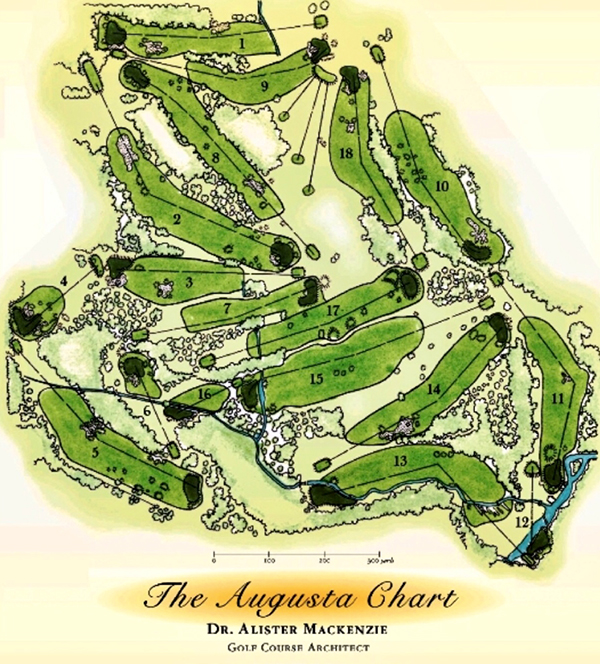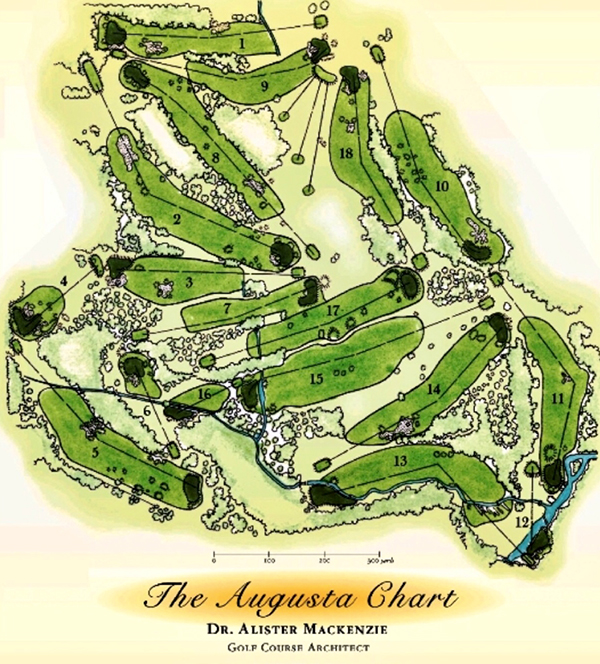
From the Random Golf Footnotes series by John Fischer III.
This is Masters week, a time when golfers of all sorts watch the tournament on television or a streaming service or, perhaps, record it to watch later. Since its inception The Masters has been played over the course of the Augusta National Golf Club, and avid viewers, or “patrons” lucky enough to have a “badge” allowing them to watch The Masters in person, know the Augusta National course almost as well as their home course.
Or so they think.
When Augusta National was designed by Dr. Alister Mackenzie with suggestions from club co-founder Bob Jones, it was to be an inland course with features of a links course. It was to have few bunkers and no rough to speak of. This wide open space made it look almost penalty-free, but the look was deceptive. Dr. Mackenzie had been a camouflage expert in World War I, and used that knowledge to play visual tricks on the unsuspecting golfer.
Mackenzie viewed play in terms of angles; the ball must be in the right place on the fairway to have a good approach to the green, and sometimes that would require a tee shot that not all golfers were capable of making. To make the course playable by everyone, there was always a safe route, or a “bailout,” which might add a stroke. Pars and birdies required two well placed shots, but a bogey wasn’t too hard to make.
Mackenzie also liked each hole to look like it naturally belonged where it was, not contrived, as though the land constituting the course had been made by divine providence especially for a golf course.
Jones agreed with Mackenzie’s design philosophy, explaining, “[t]he Augusta National had several water hazards and about half the fairways were bordered by woods. A number of mounds were introduced and, while not dangerous looking, they could be troublesome. The fairway bunkers were placed far enough out to require a well struck tee shot to carry them. The principal scoring problem, however, which required thinking and finesse, was the contouring of the greens. They were undulating to the extent that it was hard to get close to the hole, on some pin locations, unless the approach shot was made from the correct angle. Another interesting feature to us was the requirement for a run-up type of shot on several holes — especially under following wind conditions….We prefer to have keen greens at all times and they are only a shade faster during the tournament than during the preceding and following periods.”
Every golf course undergoes some changes over time. Sometimes they are to address problems of maintenance or drainage and the like, and sometimes the changes are major, reconfiguring a hole or holes, or completely replacing one or more holes, to improve aesthetics or playability.
Several general changes have been made throughout the Augusta National course since its inception. Following his desire for a natural look, Mackenzie designed his bunkers with with sand flashed up, irregular patterns and with rough edges. Now there’re no flash-faced bunkers or rough edges. All bunkers look surgically neat and the sand smooth and and even. With the rest of the course manicured perfectly, perhaps “perfect” bunkers were inevitable.
The wide open look with no rough requiring strategic ball positioning has changed too. Now Augusta has something euphemistically known as “the first cut and the second cut.” Still no rough, just one area cut higher than the other. This was done to tighten the course to combat long hitters and penalize those who stray from what we know as fairway. It has completely changed the tenor of some of the holes.
All that said, the genius of the course is its routing. It fits perfectly on the site and each hole presents a different vista, sometimes strikingly beautiful and frequently difficult to navigate.
Flipping the Nines
The late sportswriter, Dan Jenkins, famously said The Masters doesn’t start until the 10th hole on Sunday. And, in a way, that was true, because at the first Masters in 1934 what is now the 10th hole was the the first hole. It’s hard to imagine Amen Corner at the beginning of a round, but current holes four, five and six could have been something similar were they on the second nine as holes 13, 14 and 15.
The nines were reversed for the 1935 Masters, not to have stronger finishing holes, but because of frost. The Augusta National course is only open from October to May, and The Masters was originally played in March when frost could be a problem, especially on what is now the 10th hole. The green was shaded and at base of a steep valley. What is now the first hole is at a high point on the course, the green is exposed to direct sunlight and frost would burn off there quickly, so the idea was, start there and by the time players reached No. 10, the frost would not be a problem. Flipping the nines was no more than that.
To highlight how and why holes at Augusta National were “improved” (Augusta Chairman Clifford Roberts disliked the use of the word “changed” in describing alterations to the course), it’s instructive to look at a sequence of holes, for example, Nos. 10, 11, and 12.
No. 10 — “Camellia”
Par 4 — 495 Yards
There is an irregular shaped bunker in the middle of No. 10 fairway about 50 yards from the green on the crest of a hill. That hazard, known as the “Mackenzie Bunker,” is not in play but was originally designed to protect the left side of the original 10th green which was tucked away in a dip to the right.
There were two problems with the original 10th green: it was at a low point in the fairway and didn’t drain well, and the hole was too easy. The fact the hole wasn’t overly difficult may have been due to the fact it was originally intended to be the first hole.
In 1937, Perry Maxwell, a golf course architect who had worked for several years with Alister Mackenzie, suggested the green be moved to the top of a slope 50 yards farther down the fairway. Bob Jones agreed, and the placement of the new green made the hole more difficult and resolved the drainage problems experienced at the original green.
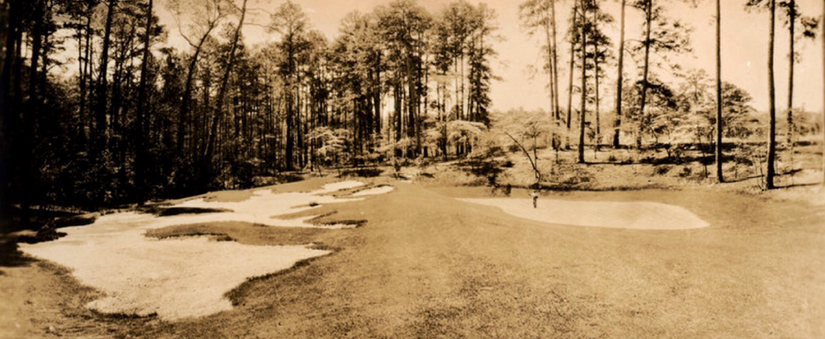
The new green changed the ideal way to play the hole. On the left side of the fairway there is a slope which will kick the ball forward and to the left, leaving the player with an open line to the green, but care must be taken not to go too far left and be tangled up in the trees. The old green rewarded a shot down the right side of the fairway and away from the Mackenzie Bunker. Today, a tee shot down the right side adds about two clubs to the approach and also brings the bunker to the right of the green into play. As on most holes at Augusta, the angle of approach must be considered.
In the afternoon, shadows make it difficult to read breaks in the green. As Freddie Bennett, longtime caddie master at Augusta, said, “You don’t read greens at Augusta, you remember them.”
This devilish par-4 is also spectacularly beautiful. Bob Jones described it best: “The green nestles on a hillside and is framed by some giant pines which give the impression of Gothic spires, and the wooded areas all around are rich in dogwood and redbud. When the dogwood is in bloom, the impression of a recent snowstorm adds great beauty to the hole.”
No. 11 — “White Dogwood”
Par 4 — 505 Yards
The 11th Hole has undergone some major improvements. Initially, the tee was on the crest of a hill to the right of the current 10th green. It played as a 415-yard par 4. A fade could produce a shorter second shot, but from a down hill lie. A straighter drive resulted in a flatter lie and a good angle to the green, with one drawback: there was a small pot bunker on that line which wasn’t visible from the tee. Bob Jones viewed the bunker as redolent of Scottish links courses and liked the idea of chance. However, after several years, the pot bunker was removed.
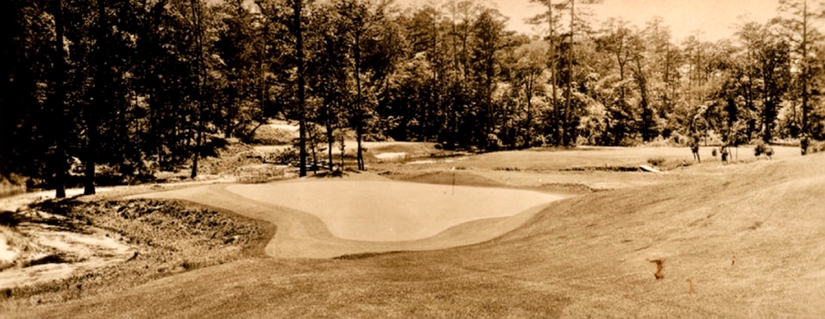
The 11th hole became too easy requiring only a short iron to the green, so in 1950 the tee was moved to a location below the 10th green in a grove of trees. Additionally the following year, at Byron Nelson’s suggestion, the part of Rae’s Creek which meandered along the left side of the 11th green was replaced by a pond which was very intimidating from the center or left side of the fairway, especially if the flagstick was on the left of the green.
Ben Hogan said that if his second shot was on the 11th green, he’d missed his shot. His plan was to play his second shot to the right of the green, taking the pond out of play, and then have a chip and a putt for his par.
With the new tee, Bob Jones estimated that a 3-iron or more would be required for the second shot, but by the 1990s players were hitting long drives down the right side of the fairway, shortening the hole and eliminating the pond as a danger. Jones felt the new pond was more of a mental hazard than an actual one. The hole was lengthened in response, and later trees were planted on the right side of the fairway to tighten the driving area. The tee was also moved back farther and shifted to the right to keep players from approaching the green from the right side of the fairway.
These later changes have made the 11th hole harder, but have removed the Mackenzie philosophy of offering players a choice. While the hole used to have a safe shot from the tee down the middle and a difficult one down the right side, now all the tee shots are to the same place, with no option to go right to gain advantage, making the hole all penal with little strategy.
No. 12 — “Golden Bell”
Par 3 — 155 Yards
No. 12 is one of the most recognizable and talked about par-3s in the world. The green was built on a natural outcropping on the far side of Rae’s Creek with a hill behind it which runs up to the Augusta Country Club. To construct the hole, 5,000 cubic yards of fill had to be removed from the opposite side of Rae’s Creek and spread on the ledge on which the green was to be located.
The green is narrow, 16 yards at its deepest point, and just nine yards deep in the area behind the front bunker. The green is subtly angled from front left to back right, and the swirling breeze around the green — some say it sometimes blows straight down — is difficult to measure and can play havoc with any shot.
It’s hard to believe today when most changes are designed to toughen up a hole, but in 1951 the right side of the twelfth hole was enlarged to make the hole easier. It was felt that a shot to a hole location on the right side of the green, the traditional Sunday location, was too difficult and bordered on being unfair.
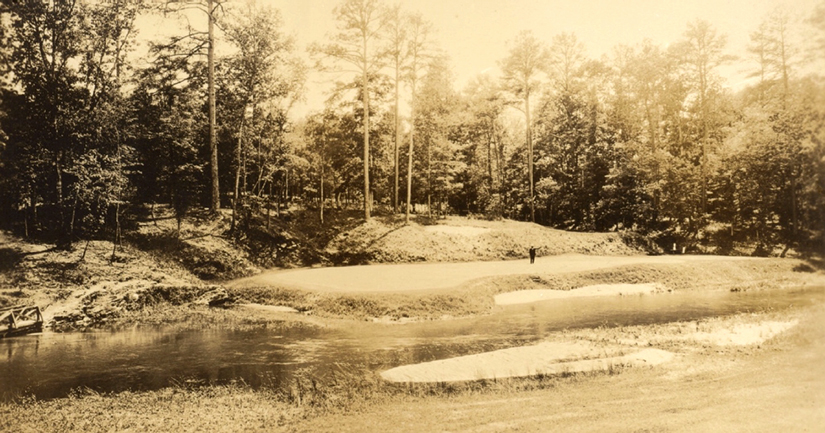
Originally the bank below the green had high grass and looked a bit scraggly. The grass is now cut close so any ball hitting on the bank short of the green will roll down the slope into the creek.
In 1960, due to flooding, the entire hole from tee to green was raised by two feet. The work was so expertly executed that the changes were not noticeable to the eye.
Mackenzie was aware that all courses are a work in progress, and those made at No. 12 would most probably have met with his approval. None of the changes altered the shot values or how it played.
Does No. 12 meet Mackenzie’s philosophy of choice and risk reward? Some believe the hole is entirely penal, that there is no safe route. Lloyd Mangrum, who held the Masters course record of 64 which stood for 46 years, described the 12th as “the meanest little par-three in the world.” However, Mackenzie thought the 12th met his standards, writing, “[t]his is an interesting pitch to a long narrow green immediately over a stream. The bold player will go for the pin on the right, while the less ambitious will steer for the larger landing area on the left side of the green. There is a steep sandy bank covered with beautiful trees beyond the green.”
The 12th is probably the least changed hole on the course.
This year brought other changes, the most significant being the lengthening of No. 5, a par-4, by 40 yards. The approach to this tiered green will be a long iron in keeping with the original design concept, so perhaps this change isn’t a change at all in terms of strategy or playability, just a return to original intent. We’ll know more after Sunday.

